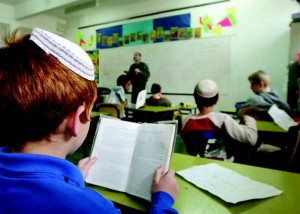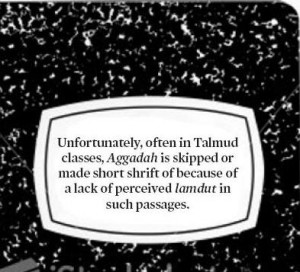A New and Potent Curriculum for the Jewish Day School
 Marvin Schick’s recent study, A Census of Jewish Day Schools in the United States 2008-9,1 clearly demonstrates growth in the number of day schools as well as significantly increased student enrollment within these institutions. Unquestionably, within the last decade, American Jews have come to accept that a crucial part of their children’s socialization into Judaism is not only the subject matter they study2 but also the educational environment in which they spend their formative years.
Marvin Schick’s recent study, A Census of Jewish Day Schools in the United States 2008-9,1 clearly demonstrates growth in the number of day schools as well as significantly increased student enrollment within these institutions. Unquestionably, within the last decade, American Jews have come to accept that a crucial part of their children’s socialization into Judaism is not only the subject matter they study2 but also the educational environment in which they spend their formative years.
Although Schick’s study is encouraging, relatively little attention has been paid by day school professionals to the nature of the day school experience in general and the Judaic studies curriculum in particular. Furthermore, few have analyzed the retention rates in terms of continued observance and affiliation of day school and yeshivah graduates. Moreover, formal regular discussions on the philosophy of education, which should ideally inform the educational process, are few and farbetween.3 It is possible that these two areas are related: Perhaps if we paid greater attention to the religious and communal activities of day school graduates, we would have greater clarity regarding what our schools do well and what they need to rethink with respect to curriculum.
Day school mission statements4 often invoke slogans5 such as “Jewish literacy,” 6 “yirat Shamayim” (fear of Heaven),7 “menschlichkeit,”8 “love of the Jewish people,9 “love of Israel,”10 “good citizenship”11 and “Torah Umadda.”12 But how are such ideas conveyed in the day-to-day school experience? 13 These various beliefs cannot substantively inform the day school experience unless the school determines how to best manifest these concepts.
I recently read Rabbi Haim Sabato’s unforgettable award-winning novel Tiyum Kavanot (Adjusting Sights),14 which raised, in my mind, some important questions with regard to day school curriculum.15 In his book, Rabbi Sabato, a co-founder and rosh metivta of the hesder yeshivah16 Birkat Moshe in Ma’aleh Adumim, describes the experiences that he and his fellow yeshivah students encountered in the fearsome battles that took place in the Golan Heights during the 1973 Yom Kippur War. The book is jarring and profound with respect to its overall literary style, realistic depiction of tank warfare and heart-wrenching psychological insights. However, as an educator, I was deeply moved by the passages quoted from Tanach, rabbinic literature and Jewish liturgy by the soldier- yeshivah student protagonists of the novel when in admittedly desperate circumstances. For example, here is Rabbi Sabato’s description of the state of mind of a tank gunner anxiously searching for a target to shoot at, realizing that his counterpart in the enemy tank is doing the same and that the ultimate survival of one can only come at the expense of the other:
I had to find him. It was up to me. Another second and he would fire. I couldn’t see a thing. Verses and snatches of Psalms came to my lips. “He will not suffer my foot to stumble.17 He that keeps thee will not slumber.18 The Lord is thy shade upon thy right hand.19 I wait for the Lord, my soul does wait, and in His word do I hope.20 He shall cover thee with His pinions and under His wings thou shall trust.21 His truth shall be thy shield and buckler.22 The angel of the Lord encamps round them that fear Him and delivers them.23 The angel of the Lord encamps round them that fear Him and delivers them. The angel of the Lord . . .”24, 25
Later in the book, the narrator describes how he struggled to observe the commandments despite the exigencies of war:
It was sunset. For the first time since my Bar Mitzva, a day of my life almost passed without putting on my tefillin. I kissed them and slipped them on to my arm, feeling the same shiver of love that I had felt in the Maimonides Synagogue. . .
Roni was on the tank, inspecting the treads. He saw me and said: What’s wrong with you? Can’t you see the sun has set? Don’t you know you don’t put on tefillin after sunset?
I ignored him. I didn’t believe the sun had set. There was still a red glow in the sky. . . Yet even as I recited the “Hear O Israel” to testify to the oneness of God, doubt gnawed at me. If only the clouds would part and reveal the sun in all its splendor, as had happened to Nakdimon Ben-Gurion in the story we learned as schoolchildren.
[At this point the story describing how a miracle was performed on behalf of a Tanna, entailing the sun appearing in the sky despite the hour of sunset having already passed, recorded in Ta’anit 19b-20a, is reprinted.]
Such was the faith and love of the ancient Rabbis and the miracles performed for them. I lifted my eyes to the sky, searching for a last ray of sunlight. Lord of the Universe! Let Your love for Your favorites be known. Miracles don’t happen every day.26
Or consider an account of a Motzaei Shabbat while on duty in the Golan, following the end of overt hostilities:
The Sabbath of the Tora portion of VaYishlach, which was the second Sabbath of the month of Kislev, was like any other. It was a rainy day. Heavy clouds covered the sky. We lingered as usual as the Sabbath drew to an end, before saying the Evening Prayer and the Havdalah blessing. Then we gazed at the sky to look for a crack that might let the new moon through. We hadn’t yet seen or blessed the moon of Kislev–the moon, the Sages said, that was like the People of Israel. For as the moon’s light reflects the sun, so does Israel reflect God’s presence, and as the moon wanes and waxes, so the destiny of Israel fades and grows bright. Moreover, the People of Israel owe the moon a special debt. This is because Rosh Hashanah, the feast of the New Year, when men’s souls are weighed in the balance and a prosecuting angel lists the sins of every Jew beneath the heavens, the still darkened moon cannot be found to give testimony. This leaves only the sun–and the Tora says: (Devarim 19:15) “One witness shall not rise up against a man for any iniquity or for any sin; at the mouth of two witnesses shall the matter be established.” And so, thanks to the moon, the People of Israel are found blameless.27
These three passages are representative of a number of others in the novel, where what young men had learned in school comes to mind at crucial junctures in their lives and powerfully informs their experiences and the manner in which they look at the world around them. From the examples above, one could claim that certain portions of Tanach should be concentrated upon due to their potential long-term importance, rather than merely consigning them to be part of a general survey. In other words, knowing what can be found in Tehillim is all well and good; however, will that knowledge necessarily serve a higher purpose “down the road” in a student’s life?
It is also interesting to recognize that the verses that came to the gunner’s mind were not consecutive, but were taken from here and there. Should such material be taught out of context to insure maximum effect, or should they remain part of entire units, but special emphasis placed upon them? Such issues are grist for the curriculum developers’ mill. It is also notable that the soldier found himself repeating a particular verse over and over like a mantra. Is this just a personal preference, or was he taught to do so? I wonder what sort of additional materials, whole books, chapters, passages or individual verses might be deemed to have similar evocative powers.
With regard to the Aggadic story that came to mind when the soldier so sincerely wanted to be able to fulfill a mitzvah that he had unwaveringly carried out every day since his Bar Mitzvah, it is fascinating to consider why that particular story proved so meaningful to him, and by extension what other narratives might have a similar effect. Unfortunately, often in Talmud classes, Aggadah is skipped or made short shrift of because of a lack of perceived lamdut (subject matter susceptible to analysis and disputation) in such passages. However, it is possible that students will remember and be affected by such stories much more than if they remember the shakla vetarya (give-and-take of a Talmudic discussion) of typical halachic sugyot (sections of the Talmud devoted to a particular topic) that are usually taught as part of the curriculum in Torah Shebe’al Peh (the Oral Tradition).
Finally, the touching meta-understanding of Kiddush Hachodesh (prayer recited on the occasion of the advent of a New Moon) that was made all the more poignant when one thinks about soldiers who are charged with literally defending the very Jewish people of whom they are thinking when reciting this prayer suggests an important aspect of tefillah education. How can prayer be presented to day school students not only in terms of understanding the words and knowing how to conduct oneself in a prayer service, but also in a manner where the themes and meaning truly matter in the short and long run?
One could claim that, thank God, most students attending Jewish day schools in the Diaspora will be spared the need to literally fight under wartime conditions. In the settings where these Jews are projected to currently reside,28 the level of safety and security is relatively high and therefore the intense danger experienced by Rabbi Sabato and his fellow yeshivah students, let alone army service in general, will not become a practical reality. But even a relatively “hum-drum” Jewish life will be filled with moments where one’s religious learning and ritual observances have the potential to make a great difference in the way in which one deals with and perceives the meaningfulness of life and its challenges. Therefore Adjusting Sights raises the question of the appropriate day school curriculum for even such Jews, i.e., has their educational experience adequately prepared them for the years to come?
Whereas it is possible to counter that someone like Rabbi Sabato is a particularly spiritual individual whose family traditions and personal learning enabled him, as well as many of the peers that he describes in his book, to call to mind sources from their standard, classic religious education that aided them in coping with their various experiences, I would contend that contemporary Jewish day school students might require a more specific and focused approach in their religious educations in order to achieve similar results.
When deciding what should be formally taught, and what sorts of affective experiences a day school should offer, we should think about which types of materials, ideas and adventures have the greatest potential for providing long-lasting, meaningful memories that we hope will be called to mind daily as well as at various junctures of one’s life. I realize that at least part of the question regarding what a particular individual remembers from his education has a great deal to do with personality, individual circumstance, family values and school environment. Nevertheless, if the subject matter can be made to be perceived by students as literally vital, indispensable and therefore truly memorable, Jewish day school education would go a long way to be more effective and a highly treasured experience by all those who are privileged to receive it.
Notes
1. AVI CHAI Foundation, 2009.
2.With the apparent initial success of a small number of public Hebrew language charter schools, it remains to be seen if in the future, a significant number of parent will demonstrate that they are only concerned about Hebrew language and culture, rather than overall religious environment.
3. A seminal exemplar of such discussions is the volume “Visions of Jewish Education,” (ed. Seymour Fox, Israel Scheffler, Daniel Marom, [Cambridge, U.K., 2003]), (see http://mandel.mli.org.il/Visions/Visions+ of+Jewish+Education/) an outgrowth of the Visions of Jewish Education Project sponsored by the Mandel Foundation (http://mandel.mli.org.il/Visions/). My own contribution to the project, “A Vision of a Modern Orthodox Jewish Education,” can be found at http://my.mli.org.il/visions/articles/Newsletter/open/Bieler.pdf.
4. Mission statements can usually be easily accessed by visiting a school’s web site. How much care was employed in crafting and implementing such a statement and whether the entire school community is not only aware of it but also “lives by it” indicate whether educational philosophy is a value affecting a school’s overall operations.
5. Referring to these concepts as “slogans” suggests that while they might be articulated in school documents such as mission statements, their programmatic and comprehensive enactment is not readily apparent in most cases.
6. Familiarity with the nature and scope of the primary texts of Jewish tradition as well as the ability to understand and analyze them.
7. Religious piety and sensitivity to Jewish moral values manifesting itself in careful observance of Torah and mitzvot, as well as the application of such values to situations encountered in the everyday world.
8. A quality that informs all interpersonal interactions whereby others are treated with respect, sensitivity and deference.
9. A positive caring attitude that encompasses all Jews, regardless of denomination, level of observance, political orientation, social class, geographical location, age, et cetera.
10. Powerful caring and concern for the welfare of the State of Israel, its institutions and inhabitants.
11. The commitment to actively participate in and positively support the general society in which one finds oneself. See my paper, “Modern Orthodox Jewish Day Schools and Non-Jews” at http://www.lookstein.org/articles/bieler_ra cism.pdf.
12. The integration to whatever extent possible of Judaic and general studies in the interests of addressing how the “whole child” will see the world in a holistic rather than a compartmentalized manner. See my paper, “Integration of Judaic and General Studies in the Modern Orthodox Day School” at http://www.lookstein.org/integration/ bieler.htm.
13. See my essay, “Preserving Modern Orthodoxy in Our Day Schools” at http://tinyurl.com/z2un2 for examples of how a particular educational frame of reference should be in evidence throughout the school program.
14. Translated by Hillel Halkin, (New Milford, Connecticut, 2004).
15. A review of this novel and others written by Rabbi Sabato appeared in Jewish Action: Shira Leibowitz Schmidt and Jessica Setbon, “Double-Take: Haim Sabato’s Books Make Waves on Israel’s Cultural Scene,” (fall 5767): 34-7.
16. A type of Zionist yeshivah where students combine Torah study with army service over the course of five years.
17. Tehillim 121:3. Since I read the book in English translation, the verses were not immediately familiar to me and I had to think for a while before I was able to identify them. In the Hebrew version, the verses would leap out at one that much more dramatically.
18. Ibid.
19. Ibid., 121:5.
20. Ibid., 130:5.
21. Ibid., 91.4.
22. Ibid.
23. Ibid., 34:8.
24. The repetition of this particular verse could be due to its having struck the author as something deeply existential, or the result of the impact that studying the following Talmudic statement might have had on the yeshivah student: Menachot 43b Rabbi Eliezer ben Yaakov says: Whoever has the tefillin on his head and on his arm, and tzitzit on his garment and a mezuzah on his doorpost, he is in the reliable status of one who will not sin, as it is said, (Kohelet 4:12) “And the three-strand chord [tefillin, tzitzit, mezuzah] will not quickly be severed,” and (Tehillim 91:4) “The angel of the Lord encamps round them that fear Him and delivers them.”
25. Adjusting Sights, p. 32.
26. Ibid., pp. 87-88.
27. Ibid., p. 137.
28. The degree to which students’ possible aliyah will have to be taken into consideration by a day school will depend upon a percentage of graduates of a particular school, with or without their families, making such a decision. This point will not be addressed here.
Rabbi Yaakov Bieler is the rabbi of the Kemp Mill Synagogue in Silver Spring, Maryland. He has lectured and written extensively on the philosophy of Jewish education and worked in day schools for over thirty years.


